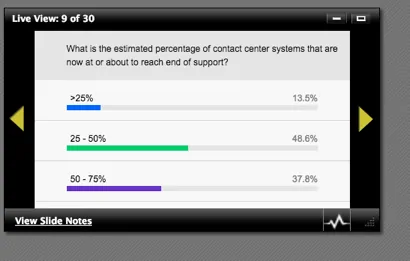Your Genesys Blog Subscription has been confirmed!
Please add genesys@email.genesys.com to your safe sender list to ensure you receive the weekly blog notifications.
Subscribe to our free newsletter and get blog updates in your inbox
Don't Show This Again.

Contact center modernization is far more than just a popular buzzword. It’s a powerful mix of technology, strategy, process and company culture that has become a fundamental focus for meeting rapidly evolving customer expectations. New technologies—artificial intelligence (AI), machine learning, bots, predictive routing and more—are not only changing customer engagement models, they’re providing new opportunities to drive business revenue and efficiency. Yet, despite the ever-increasing number of success stories from companies who have elected to move to a modern contact center platform, many remain rooted in place with legacy systems.
We sat down with Art Schoeller, Vice President and Principal Analyst at Forrester Research, for a Q&A session on the topic of contact center modernization after he shared valuable insights in our global webinar, “Expert forum: Choosing the best path for transforming a legacy contact center.”
What is a legacy contact center infrastructure?
Art Schoeller: The use of the term infrastructure indicates the older, more proprietary and phone-based hardware approach to contact center applications. Today, this architecture has given way to more modern software suites running on standardized servers. These more integrated applications provide omnichannel capabilities and are shifting to cloud-based software-as-a-service (SaaS) delivery.
Why is it important for IT and the business side to have a modern customer experience platform?
Schoeller: There tends to be a lot of inertia when it comes to migrating to newer technology in contact centers since the people, processes, and technology are so intertwined to deliver customer service—day in and day out. Many times, the compelling event is the end of life of critical systems and the significant investment required to upgrade. But there are several other factors creating risk that can add up to drive an upgrade decision. Securing older platforms is much more expensive. Lack of support for omnichannel creates competitive risk. Inflexible systems that prevent trialing newer, innovative and differentiated customer journeys prevent an organization from becoming customer obsessed. And older systems hinder the ability to embed artificial intelligence into contact center applications.
What are the top three IT considerations for upgrading to a consolidated modern contact center/customer experience platform?
Schoeller:
What are your thoughts on the following poll data regarding systems approaching end of support?

Schoeller: The audience responses indicate many systems are hitting an upgrade window. As many organizations over the last decade have migrated to server- and VoIP-based systems, these are now nearing the end of their lifecycle.
What are the top three reasons businesses put off an upgrade or migration to a consolidated modern contact center/customer experience platform?
Schoeller:
Are we seeing a shift in the business drivers for making a change?
Schoeller: It was interesting to see such a large majority of responses to this poll. The more typical issue of risk created by older technology is what I would have expected, but the audience chose the business limitations instead. So, this indicates that the competitive pressures to deliver efficient and effective customer service from their contact centers has become a top concern.
These are just a few expert insights on contact center transformation and legacy migration. Hear more in the webinar, which is available on-demand.
Subscribe to our free newsletter and get blog updates in your inbox.